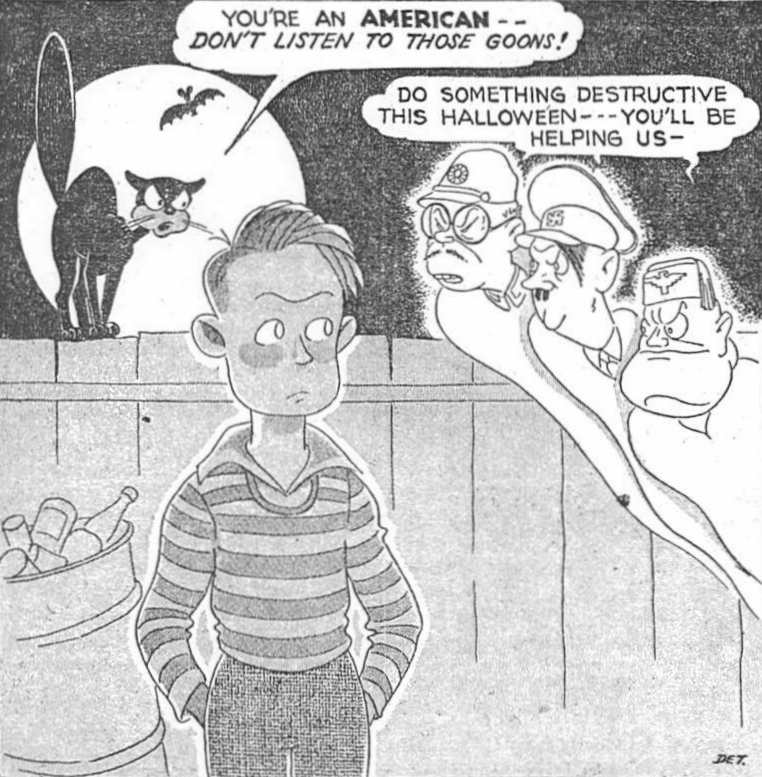|
Welcome to The Food Historian's 31 Days of Halloween extravaganza. Between social media (Facebook, Instagram, Twitter) and this blog, I'll be sharing vintage Halloween content nearly every day this month!  Cartoon published in the "San Diego Union," October 25, 1942. Ghosts of Emperor Hirohito of Japan, Adolph Hitler of Germany, and Benito Mussolini say in unison, "Do something destructive this Halloween - you'll be helping us -" to a teenaged boy in an alley. A black cat on the fence behind him says, "You're an AMERICAN - don't listen to those goons!" Trick or treating today is usually about young children, costumes, and lots of candy. In many communities, it's over by 8 or 9 pm. But historically, trick or treating was more about the tricks than the treats. Going door to door threatening tricks if treats were not offered instead is very old, but has deeper roots in association with Christmas than with Halloween. Despite the tradition's age, going door to door for treats on Halloween was not widely practiced in the United States until the 20th century. The pranks, however, were popular among teenaged boys. From the relatively harmless pranks like soaping car windows and placing furniture on porch roofs to the destructive ones like slashing tires, breaking windows, egging houses, and starting fires in the streets, pranks were common in communities across the country. The war changed all that. Halloween, 1942 was the first since the United States entered the war in December, 1941. Across the nation, newspapers published warnings to would-be prankers that destructive acts of the past would no longer be tolerated. This one, published on October 30, 1942 in The Corning Daily Observer in Corning, California, was typical of other messages other newspapers: "Hallowe'en Pranks Are Out For the Duration" "The destructive Hallowe'en pranks of breaking fences, stealing gates, deflating auto tires, ringing door bells to disturb sleepers, soaping windows, and all other forms of the removal or destruction of buildings or property are definitely out and forbidden on Hallowe'en night, according to word from Corning city officials. "Supplies are needed for national defense and are too scarce to permit misuse. "Word comes from Washington that individuals committing such offense shall be prosecuted as saboteurs and be treated accordingly. "Corning officials state that there will be no fooling about this matter this year and anyone contemplating 'having fun' will be treated with severely." The newspaper cartoon above, published in the San Francisco Union on October 25, 1942, illustrates just this sentiment. In it, the ghosts of Japanese Emperor Hirohito, German Chancellor Adolph Hitler, and Italian fascist Prime Minister Benito Mussolini egg on a young boy hanging out in a dark back alleyway. "Do something destructive this Halloween - - - You'll be helping us - " they tell him. On the high fence behind the boy stands a black cat, back arched in anger, silhouetted by a full moon. He says to the boy, "You're an American - - Don't listen to those goons!" Conflating Halloween pranks with sabotage and aiding the Axis powers was no joke. The November, 1942 newspapers feature stories of pranksters waking sleeping war workers, scaring their neighbors by setting off air raid bells, and causing car accidents by leaving debris in the roads. Several ended up in court, and some got buckshot wounds from angry homeowners for their efforts. Wartime propaganda like this was common - caricatures of the Axis leaders showed up frequently in newspapers, cartoons, and propaganda posters. For Halloween, they made convenient bogeymen. World War II was the beginning of the end of Halloween tricks. Although more innocuous pranks like egging houses and cars and toilet-papering trees and porches continued to be hallmarks of Halloween mischief, the days of fires in the streets, broken windows, and other real crimes were largely in the past. Communities that had previously celebrated Halloween with private parties at home, shifted to more public events like parades, community dances, and trick-or-treating geared toward small children getting treats rather than teenagers engaging in tricks. Further Reading If you'd like to learn more about Halloween during World War II, check out these additional resources:
The Food Historian blog is supported by patrons on Patreon! Patrons help keep blog posts like this one free and available to the public. Join us for awesome members-only content like free digitized cookbooks from my personal collection, e-newsletter, and even snail mail from time to time! Don't like Patreon? Leave a tip!
0 Comments
|
AuthorSarah Wassberg Johnson has an MA in Public History from the University at Albany and studies early 20th century food history. Archives
July 2024
Categories
All
|

 RSS Feed
RSS Feed